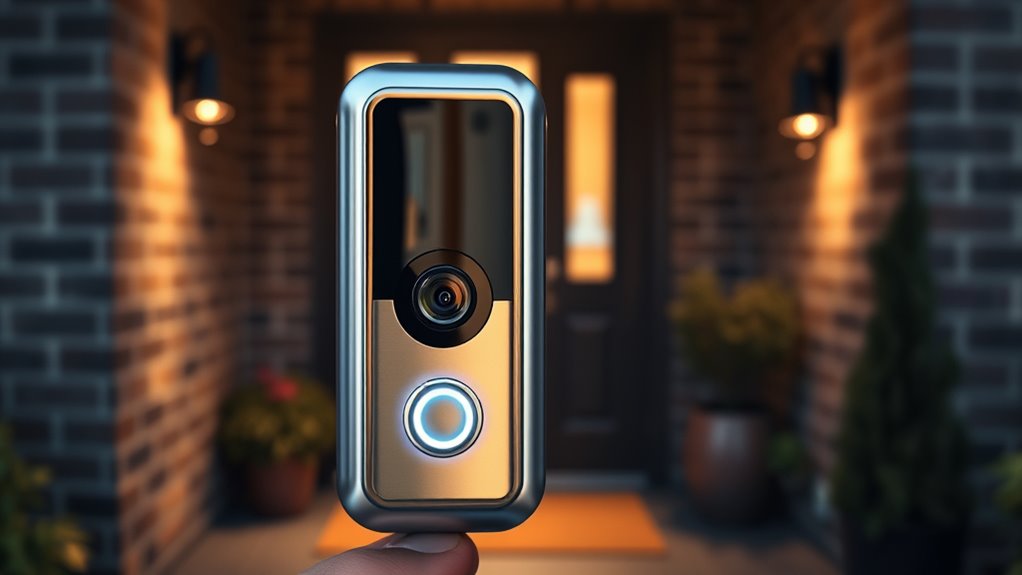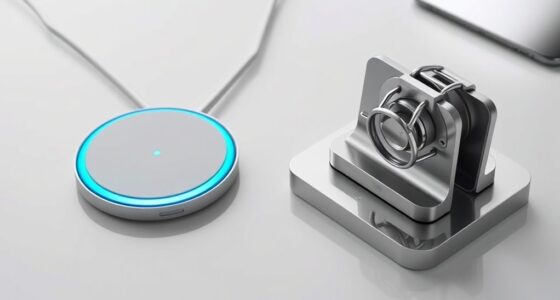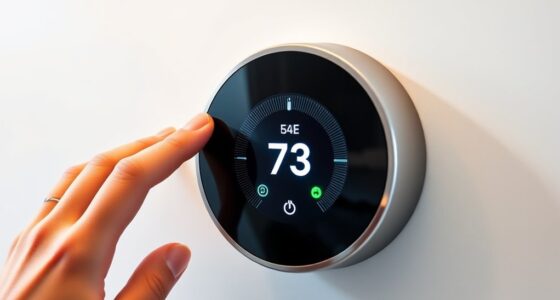When you press a smart doorbell button, it immediately sends a signal via Wi-Fi or wireless protocols, triggering audible chimes and notifications on your devices. The doorbell then establishes a secure connection, encrypts data, and streams live video and audio of your visitor. Footage may be recorded for later review. If you’re curious about how each step keeps your home safe and connected, keep exploring each part of the process.
Key Takeaways
- Pressing the button triggers immediate chimes, notifications, and initiates communication with the home’s Wi-Fi network.
- The doorbell transmits signals via Wi-Fi, Bluetooth, or wired connections, ensuring secure data encryption during transmission.
- It authenticates users through encryption and multi-factor authentication, protecting video feeds and personal data.
- Live video and audio are streamed, recorded locally or in the cloud, with options for remote control and playback.
- The system sends alerts to multiple devices, allowing customization, security management, and seamless user interaction.
The Moment You Press the Button
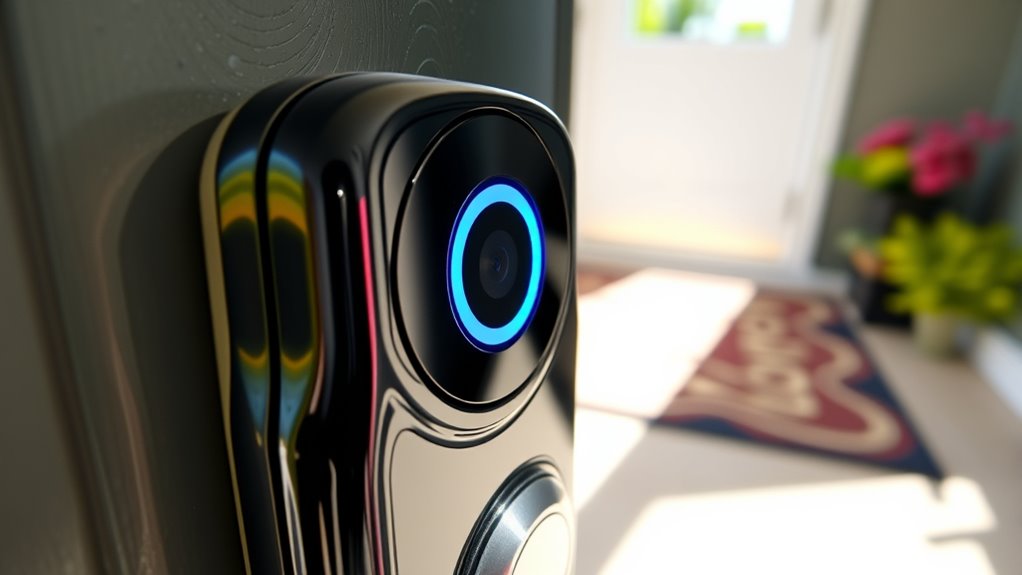
When you press the button on a smart doorbell, it instantly triggers a series of digital responses. You’ll hear the familiar doorbell chimes, which confirm your action and alert the homeowner. This immediate sound enhances the user experience by providing clear feedback that your press was registered. Behind the scenes, the device communicates with your Wi-Fi network, preparing to send a notification to the homeowner’s device. The chimes serve as both a practical cue and an integral part of the doorbell’s interactive design. This quick and seamless response ensures you feel connected and confident that your visit has been noticed. Overall, this initial moment sets the tone for the entire user experience, making it intuitive and satisfying.
Signal Transmission to the Doorbell
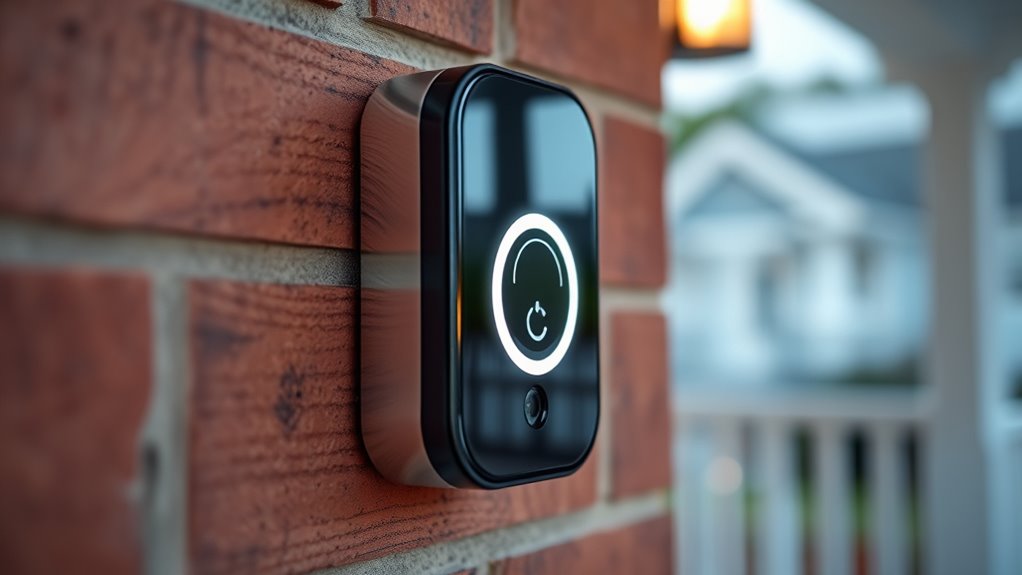
When someone presses your doorbell, the signal needs to reach it quickly and securely. You’ll find that some doorbells use wireless signals like Wi-Fi or Bluetooth, while others rely on wired connections. To keep your data safe, many systems also incorporate encryption methods that protect your privacy.
Wireless Signal Pathways
Wireless signal pathways are essential for transmitting notifications from your doorbell to your connected devices. They rely on a few key methods to ensure you’re always informed.
- Wi-Fi connection: Your doorbell uses your home’s Wi-Fi network, offering quick, reliable communication, but it can drain battery life if not optimized.
- Zigbee or Z-Wave protocols: These low-power wireless standards reduce battery consumption and are more weather-resistant, ideal for outdoor use.
- Cellular networks: Some smart doorbells connect directly via cellular signals, providing coverage even without Wi-Fi but may impact battery life with frequent use.
Choosing the right pathway depends on your environment, weather resistance needs, and how long your battery lasts between charges.
Wired Connection Mechanisms
Wired connection mechanisms transmit signals directly from your doorbell to your home’s electrical system or dedicated wiring. These systems rely on a stable power supply from your existing electrical setup, ensuring consistent operation without needing batteries. Installation options typically involve connecting the doorbell to the existing chime wiring or installing a new circuit. This method provides reliable signal transmission, reducing lag or interference issues common with wireless systems. Wired doorbells are often preferred for their durability and straightforward power supply, especially in homes where wiring is already in place. Keep in mind, installation can be more involved than wireless options, but it offers a dependable connection that’s less susceptible to disruption. Once connected, your doorbell stays powered and ready to alert you whenever someone presses the button.
Signal Encryption Methods
To keep your smart doorbell secure from potential eavesdroppers and hacking attempts, manufacturers use various signal encryption methods during transmission. These methods rely on encryption algorithms to safeguard your data privacy. When your doorbell transmits a signal, it typically:
- Encrypts the data using advanced algorithms like AES or RSA, making it unreadable without a key.
- Uses secure protocols such as WPA3 or TLS to protect communication between devices.
- Regularly updates encryption keys to prevent unauthorized access, ensuring ongoing data privacy.
- The choice of contrast ratio can also influence the clarity of the transmitted video, especially in dark scenes.
These encryption techniques ensure that the video feeds, audio, and control signals stay confidential, preventing hackers from intercepting or tampering with your smart doorbell’s transmissions.
Connecting to Your Wi-Fi Network
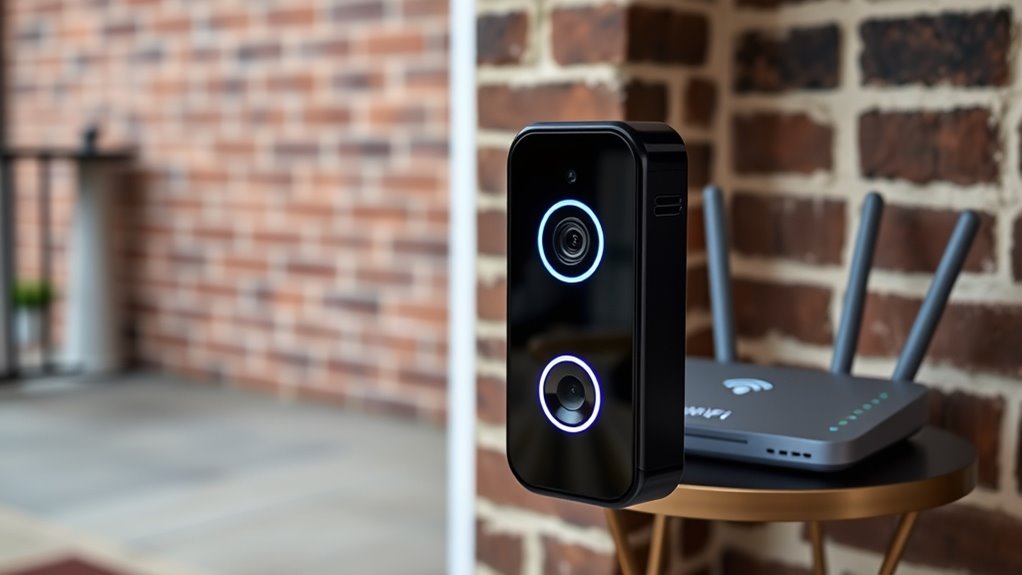
Connecting your smart doorbell to your Wi-Fi network is a straightforward process that guarantees it functions properly. First, ensure your network configuration is compatible, with a stable connection and the correct password. Use the doorbell’s app to initiate setup, which will guide you through selecting your Wi-Fi network. If you encounter Wi-Fi troubleshooting issues, such as connection drops or slow speeds, try moving your router closer or resetting your network. Keep your firmware updated to avoid compatibility problems. Once connected, your doorbell should sync seamlessly, allowing live video streaming and notifications. Remember, a solid Wi-Fi connection is essential for optimal performance. If issues persist, consult the device’s support resources or reset your network settings before attempting to reconnect. Incorporating sound healing science principles, such as ensuring minimal interference, can also help improve connection stability.
Authentication and Data Encryption

Once your smart doorbell is connected to your Wi-Fi network, safeguarding your data becomes the next vital step. You’ll want to ensure robust authentication and encryption. Here’s what that involves:
- Implementing biometric verification, like fingerprint or facial recognition, to prevent unauthorized access.
- Applying data privacy protocols that encrypt your video feeds and personal information during transmission and storage.
- Using strong, unique passwords and two-factor authentication to add extra layers of security.
These measures ensure that only authorized users can access the device and that your data remains confidential. Encryption scrambles your data, making it unreadable to outsiders, while biometric verification confirms your identity before granting access. This keeps your smart doorbell secure and your privacy protected.
Notifying Your Smartphone or Device
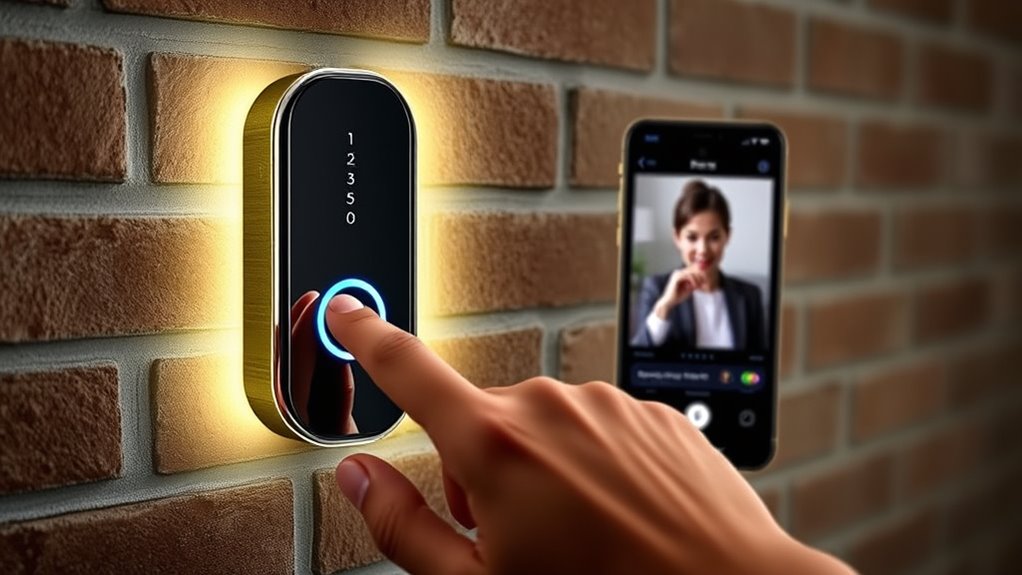
Your smart doorbell keeps you informed with instant notification alerts whenever someone approaches. You can customize these alerts to match your preferences and avoid unnecessary interruptions. Plus, multi-device synchronization guarantees you stay updated whether you’re using your phone, tablet, or other connected devices. Implementing mobile responsiveness ensures your notifications are clear and accessible across all your devices.
Instant Notification Alerts
Instant notification alerts are a key feature that keeps you informed about activity at your door in real-time. When someone presses your doorbell, you get instant updates on your smartphone or device, so you’re always in the loop. These alerts can include:
- A loud doorbell chime notification, alerting you immediately.
- A live video feed showing visitor identification, so you know who’s at your door.
- Customizable alerts, letting you choose which activities trigger notifications.
- Affiliate commissions from products related to smart doorbells may be earned when you make a purchase, supporting the continued development of helpful content.
This immediate feedback helps you decide whether to answer, ignore, or prepare for a visitor. You’ll never miss a package delivery or an unexpected guest, all without constantly checking your door. Instant alerts keep you connected, safe, and aware at all times.
Customizable Notification Settings
Customizable notification settings give you control over how and when your smart doorbell alerts you. You can adjust motion detection sensitivity to avoid false alarms or missed visitors, ensuring you’re notified only when necessary. Visitor identification features let you set specific alerts for recognized visitors or unknown ones, so you stay informed without constant alerts. For example, you might receive a notification when a familiar face is detected or when motion is detected in certain zones around your door. These settings help tailor your experience, making sure you’re only alerted about relevant activity. You can often choose to mute notifications during certain hours or create custom rules based on time or activity, giving you peace of mind and reducing unnecessary interruptions. Additionally, understanding the environmental considerations of smart technology can help you optimize your notification settings for both security and sustainability.
Multi-Device Synchronization
Multi-device synchronization guarantees you stay connected to your smart doorbell no matter where you are. It relies on robust inter device communication and synchronization protocols to keep all your devices updated simultaneously. When someone presses your doorbell, notifications instantly appear on your smartphone, tablet, or smartwatch. Additionally, many systems are compatible with security zone info, ensuring your setup is both reliable and scalable as your needs grow.
Here’s how it works:
- The doorbell communicates via Wi-Fi or Bluetooth using secure synchronization protocols.
- Alerts are pushed instantly to all connected devices.
- Your devices stay in sync, displaying the same real-time video feed, alerts, or snapshots.
This seamless setup ensures you don’t miss any activity, whether you’re at home or away. Multi-device synchronization creates a reliable ecosystem, keeping you informed and in control at all times.
Streaming Live Video and Audio
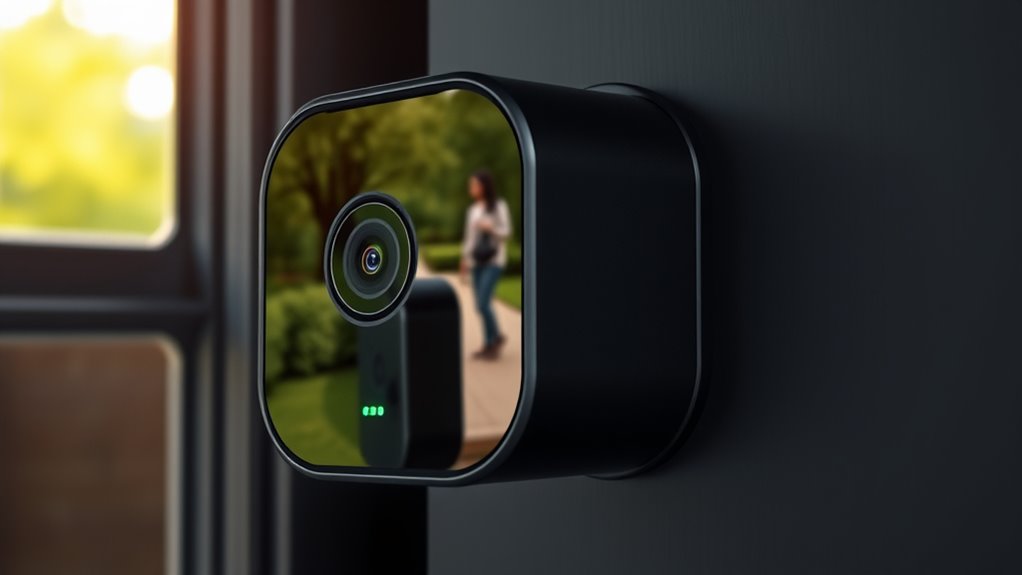
Have you ever wondered how smart doorbells let you see and hear what’s happening outside your door in real-time? It all comes down to streaming live video and audio through your connected device. Modern doorbells deliver high-quality video, so you can clearly see visitors or package deliveries, even in low light. The video quality guarantees you get sharp, detailed images, making identification easier. Meanwhile, audio clarity allows you to communicate directly with visitors or delivery personnel without any confusing echoes or background noise. This real-time streaming happens instantly, giving you peace of mind and control no matter where you are. Whether you’re at work or on vacation, you can always stay connected and aware of what’s happening outside your door. Proper maintenance and placement can ensure the streaming quality remains consistent and reliable.
Recording and Storing Footage
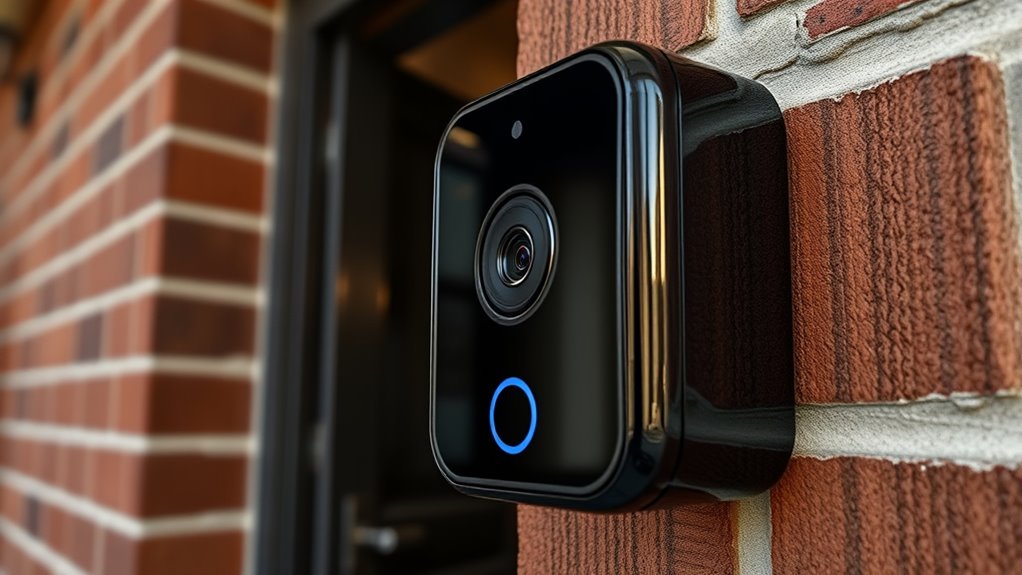
Recording and storing footage is a crucial feature that guarantees you have access to video recordings even after the live stream ends. When your smart doorbell captures footage, it’s stored either locally or in the cloud, ensuring you won’t lose important moments. Here’s what happens next:
- You can revisit recorded footage through easy video playback, allowing you to review events at your convenience.
- The system automatically creates a footage backup, protecting recordings from device failure or theft.
- If needed, you can download or share specific clips, making it simple to provide evidence or relive memorable moments.
- Regular updates and proper maintenance of the device help ensure consistent recording quality and filter effectiveness, so your footage remains clear and reliable.
This setup guarantees your footage is safe, accessible, and ready whenever you need it, providing peace of mind and enhanced security.
User Interaction and Home Security Management
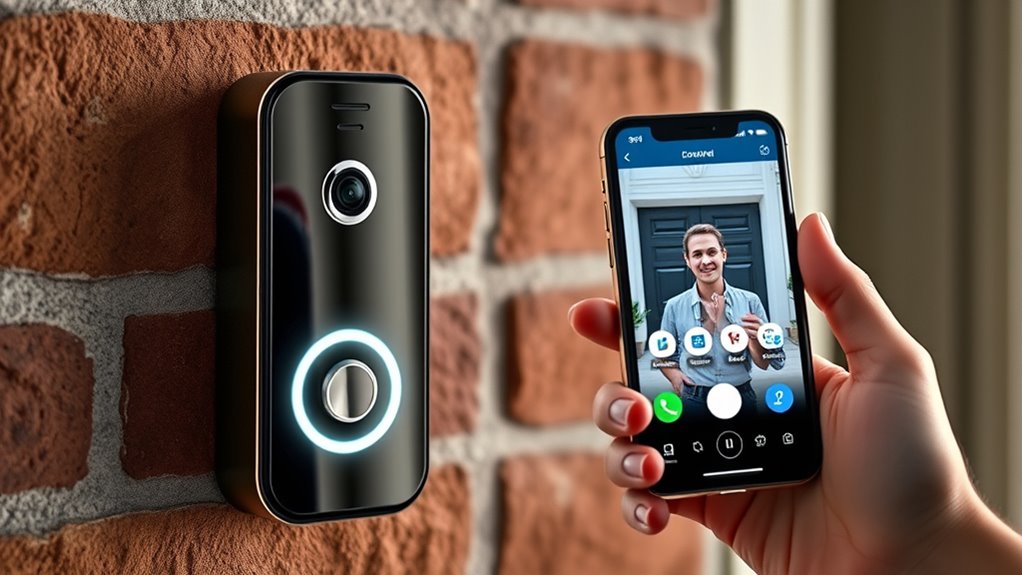
User interaction with smart doorbells allows you to communicate instantly with visitors, whether they’re at your doorstep or through a connected app. Voice recognition technology enables hands-free control and quick responses, making interactions more seamless. However, it’s vital to consider user privacy, as smart doorbells collect data on your conversations and visitors’ identities. Many systems offer customizable privacy settings, so you can control who accesses your footage and audio recordings. Managing these features ensures your home security stays tight without sacrificing your privacy. You can also set permissions for family members or service providers, maintaining control over your smart doorbell’s capabilities. Additionally, AI security technologies help identify potential threats or unauthorized access attempts, further enhancing your home’s safety. Ultimately, effective user interaction enhances security and convenience, but it’s essential to stay aware of how your data is used and protected.
Frequently Asked Questions
How Long Does the Battery Last on Most Smart Doorbells?
You probably wonder how long the battery lasts on most smart doorbells. Typically, their battery life ranges from 1 to 6 months, depending on power consumption and usage frequency. Lower power consumption models last longer, especially if you enable features like motion alerts or video recordings sparingly. Regularly charging or replacing the battery guarantees your doorbell stays functional, and choosing a device with efficient power use helps extend its overall battery life.
Can I Install a Smart Doorbell Without Professional Help?
You can definitely handle DIY installation of a smart doorbell, but you should check for compatibility concerns first. Make sure your existing doorbell wiring and Wi-Fi setup match the product’s requirements. Follow the manufacturer’s instructions carefully, and use available tools like screwdrivers and voltage testers. If you’re comfortable working with electrical components and troubleshooting, you probably won’t need professional help. However, if you’re unsure, consulting an expert guarantees safety and proper setup.
Do Smart Doorbells Work During Power Outages?
Imagine your smart doorbell standing vigil at your door, but during a power outage impact, it might go dark. Most smart doorbells rely on your home’s power, so a blackout can disable live video and alerts. However, you can add backup power options like batteries or UPS systems to keep it running. This way, even during a power outage, you stay connected and informed about visitors at your door.
Are Smart Doorbells Compatible With All Home Security Systems?
You might wonder if video doorbells work with your existing security system. Many wireless connectivity-enabled smart doorbells are compatible, but it varies by brand and model. Some integrate seamlessly, while others need specific hubs or adapters. Check your system’s compatibility before purchasing. Most modern video doorbells are designed to connect easily, giving you real-time alerts and video feeds, making your home more secure without replacing your entire security setup.
How Do I Update the Firmware on My Smart Doorbell?
Did you know that 85% of smart device users neglect firmware updates? To update your smart doorbell’s firmware, open its app and navigate to settings. Look for “Device Compatibility” or “Firmware Updates” options. If an update is available, follow the prompts to download and install it. Regular firmware updates improve security and functionality, so keep your device current to guarantee peak performance.
Conclusion
Now that you press the doorbell, it’s like opening a window to your home’s front porch, inviting a stream of real-time video, alerts, and security updates. As data zips through wifi, it keeps you connected and protected, turning your doorbell into a vigilant guardian. With every tap, you’re not just ringing a bell—you’re orchestrating a smarter, safer home, making security feel as natural as opening your front door.
